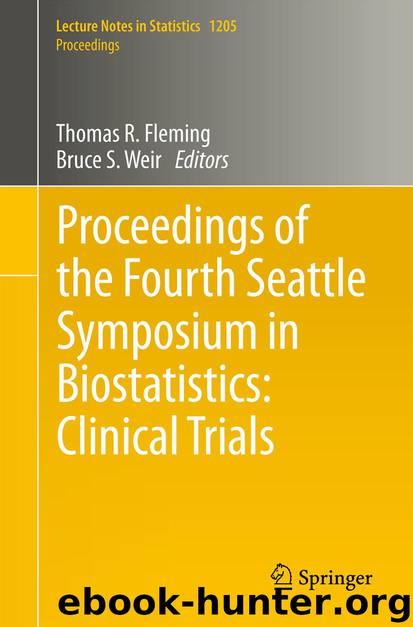Proceedings of the Fourth Seattle Symposium in Biostatistics: Clinical Trials by Thomas R. Fleming & Bruce S. Weir

Author:Thomas R. Fleming & Bruce S. Weir
Language: eng
Format: epub
Publisher: Springer New York, New York, NY
7 Hedging Bets in Design and Analysis
Realistically, studies will, and I believe should, continue to be performed globally. The questions sponsors and other designers must face is how best to design and analyze studies in a way that allows generalization to the country of interest, which here we assume is the USA. Thinking about how to generalize is best done prior to initiation of the trial. One approach, which is not likely to be used in large Phase 3 trials, is to minimize reliance on data from outside the USA; another is to write careful entry criteria to assure that patients outside the USA have a condition that is similar to the experience in the USA and treatments that would reflect what would happen in the USA. An alternative that I prefer is rather than limit the population by adopting extensive entry criteria, collect data that allow characterization of the population. Obviously, all studies should be conducted in way that provides reliable evidence regarding efficacy and safety.
Marschner [28] shows a graph depicting the expected magnitude of effect sizes when all regions have the same number of participants and when the true effect size in all regions is equal (Fig. 3). He recommends describing in the protocol or analysis plan the expected distribution of these order statistics. While his paper deals with equal size groups, his approach can easily be adapted to different sizes. His striking graph shows the wide variability in expected treatment sizes as the number of regions increases. This theoretical demonstration of the data shown in Fig. 1 can be applied not only to regional differences, but to other types of subgroups as well. Including such a graph in an analysis plan or a design paper, where the calculations are based on the actual sample sizes expected by region, would provide a warning to those designing the trial and those interpreting the data to expect variation in effect size.
Fig. 3Expected range of regional treatment effects in a trial with 80% power for a treatment difference of δ and a two-sided Τype 1 error rate of 0.05. For each range, the jth tick mark from the left denotes the expected value of the jth largest regional treatment effect. (Figure from Ian C. Marschner [28]; Clinical Trials (Vol. 7, issue 2), page 150, copyright © 2010 by Sage Publishing. Reproduced by permission of SAGE)
Download
This site does not store any files on its server. We only index and link to content provided by other sites. Please contact the content providers to delete copyright contents if any and email us, we'll remove relevant links or contents immediately.
Algorithms of the Intelligent Web by Haralambos Marmanis;Dmitry Babenko(9832)
Test-Driven Development with Java by Alan Mellor(7657)
Data Augmentation with Python by Duc Haba(7541)
Principles of Data Fabric by Sonia Mezzetta(7317)
Learn Blender Simulations the Right Way by Stephen Pearson(7233)
Microservices with Spring Boot 3 and Spring Cloud by Magnus Larsson(7067)
RPA Solution Architect's Handbook by Sachin Sahgal(6458)
Jquery UI in Action : Master the concepts Of Jquery UI: A Step By Step Approach by ANMOL GOYAL(6447)
The Infinite Retina by Robert Scoble Irena Cronin(6169)
Hadoop in Practice by Alex Holmes(6138)
Big Data Analysis with Python by Ivan Marin(5884)
Life 3.0: Being Human in the Age of Artificial Intelligence by Tegmark Max(5474)
Pretrain Vision and Large Language Models in Python by Emily Webber(4841)
Infrastructure as Code for Beginners by Russ McKendrick(4623)
WordPress Plugin Development Cookbook by Yannick Lefebvre(4342)
Functional Programming in JavaScript by Mantyla Dan(4216)
The Age of Surveillance Capitalism by Shoshana Zuboff(4209)
Embracing Microservices Design by Ovais Mehboob Ahmed Khan Nabil Siddiqui and Timothy Oleson(4114)
Applied Machine Learning for Healthcare and Life Sciences Using AWS by Ujjwal Ratan(4092)
